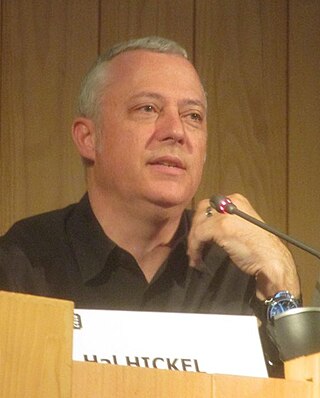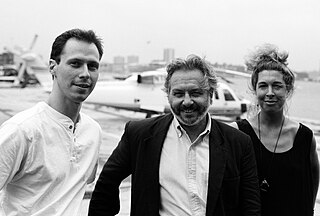Related Research Articles
Industrial Light & Magic (ILM) is an American motion picture visual effects company that was founded on May 26, 1975 by George Lucas. It is a division of the film production company Lucasfilm, which Lucas founded, and was created when he began production on the original Star Wars, now the fourth episode of the Skywalker Saga.

Skywalker Sound is the American sound effects, sound editing, sound design, sound mixing and music recording division of Lucasfilm. Founded in 1975, the company's main facilities are located at George Lucas's Skywalker Ranch in Lucas Valley, near Nicasio, California.

Stanley Winston was an American television and film special make-up effects creator, best known for his work in the Terminator series, the first three Jurassic Park films, Aliens, The Thing, the first two Predator films, Inspector Gadget, Iron Man, and Edward Scissorhands. He won four Academy Awards for his work.

Dennis Muren, A.S.C is an American film visual effects artist and supervisor. He has worked on the films of George Lucas, Steven Spielberg, and James Cameron, among others, and has won nine Oscars in total: eight for Best Visual Effects and a Technical Achievement Academy Award. The Visual Effects Society has called him "a perpetual student, teacher, innovator, and mentor."
Gary Roger Rydstrom is an American sound designer and film director. He has been nominated for 20 Academy Awards for his work in sound for movies, winning 7.
Michael Lantieri is a special effects supervisor.

Hal T. Hickel is a visual effects animator for Industrial Light & Magic.
Every year since its inception, the Japanese Academy has recognized an outstanding foreign film. The year that any given film is nominated is not based on the film's domestic release date but rather on the date it is released in Japan. As delays of over four months are not uncommon, many films are nominated in Japan the following year after their release to the Japanese market. In fact, not one of the five films nominated for the 2007 Academy Award for Best Picture had been released in Japan by February 15, 2008, the date of the Japan Academy Prize Ceremony.
George Gibbs was a British special effects artist who is best known for his work in Indiana Jones and the Temple of Doom, Who Framed Roger Rabbit and Indiana Jones and the Last Crusade.
Kenneth F. Smith is a special effects artist. He works at ILM as well. He also won 2 Academy awards.
Ben Snow is a special effects artist who has been nominated four times at the Academy Awards. He works at Industrial Light & Magic.

John Bruno is an American visual effects artist and filmmaker known for his prolific collaborations with director James Cameron on films like Terminator 2: Judgment Day, True Lies, Titanic, Avatar, and The Abyss, for which he won the Academy Award for Best Visual Effects.
Steve Gawley is a visual effects artist who was nominated at the 62nd Academy Awards in the category of Best Visual effects for his work on the film Back to the Future Part II. His nomination was shared with John Bell, Michael Lantieri and Ken Ralston.
Ed Hirsh is a special effects artist who was nominated at the 74th Academy Awards in the category of Best Visual Effects for his work on Pearl Harbor. He shared his nomination with Eric Brevig, John Frazier and Ben Snow.
Michael J. McAlister is a special effects artist. He has been nominated on at least eleven occasions for special or visual effects awards and has won at least three of such awards: an Oscar, a BAFTA and an Emmy.
Paul Kavanagh is a British visual effects artist who was nominated at the 82nd Academy Awards in the category of Best Visual Effects for his work on Star Trek. His nomination was shared with Burt Dalton, Russell Earl and Roger Guyett. In 2016, he and his colleagues Chris Corbould, Roger Guyett and Neal Scanlan received the BAFTA-Award in the category of Best Special Visual Effects for their work on Star Wars: The Force Awakens. They were also nominated for an Academy Award, but lost to Ex Machina.
John Bell is a special effects artist who was nominated at the 62nd Academy Awards in the category of Best Visual effects for his work on the film Back to the Future Part II. His nomination was shared with Steve Gawley, Michael Lantieri and Ken Ralston.
David Berry is a special effects artist who won at the 58th Academy Awards in the category for Best Visual Effects for his work on the film Cocoon. His win was shared with Scott Farrar, Ralph McQuarrie and Ken Ralston.
Donald R. Elliott is a visual effects supervisor. He won at the 85th Academy Awards for his work on the film Life of Pi. This was in the category of Best Visual Effects. He shared his win with Erik-Jan de Boer, Guillaume Rocheron and Bill Westenhofer.
Jason H. Snell is an American special effects supervisor known for his works in Disney's visual effects company Industrial Light & Magic (ILM). Snell has worked as a production coordinator and VFX supervisor in films, Men in Black (1997), Pirates of the Caribbean (2003-07), Star Wars: Episode III – Revenge of the Sith (2005), Indiana Jones and the Kingdom of the Crystal Skull (2008), Battleship (2012), Star Trek Into Darkness (2013), Tomorrowland (2015), Monster Hunt (2015), Deepwater Horizon (2016), Silence (2016) and Monster Hunt 2 (2018).
References
- ↑ "The 57th Academy Awards (1985) Nominees and Winners". oscars.org. Retrieved April 1, 2014.